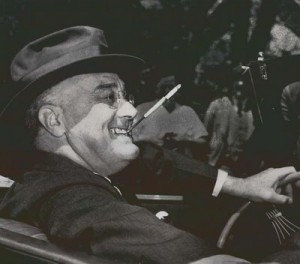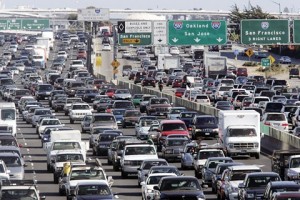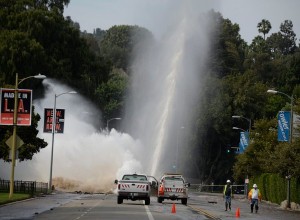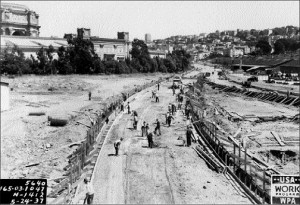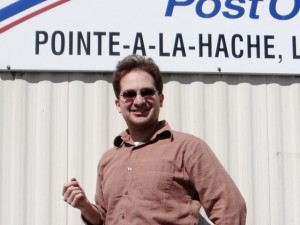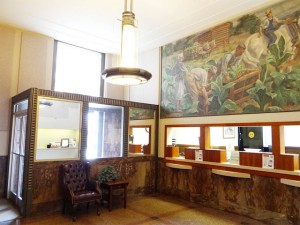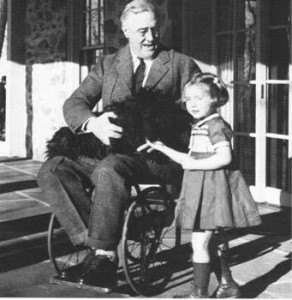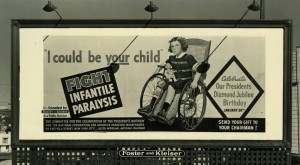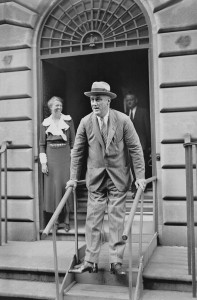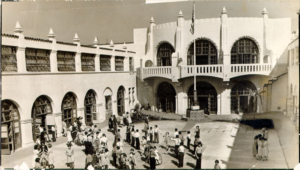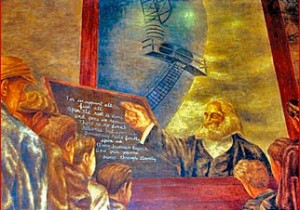
Ben Shahn Mural at the Bronx Post Office
“America at Work” is one of thirteen murals in the Bronx post office
Despite vigorous protest by the public and public officials, the Bronx General Post Office has been sold. Valued at $14 million, the building reportedly was sold to Korean developer Young Woo & Associates for an undisclosed sum. The U.S. Postal Service has not made an official announcement about the sale and has declined to provide details.
“The United States Postal Service has sold one of the Bronx’s most important community and historic treasures in a completely irresponsible manner,” Bronx Congressman Jose Serrano said. “The USPS has disregarded the voices of the Bronx community, elected officials, historic preservationists, and their own employees—all of whom opposed this process and this sale.”
In 2013 the Postal Service announced its intention to sell the massive Bronx Post Office in order to “right-size our retail operation into smaller leased space,” according to Joseph Mulvey, a real estate specialist for the Postal Service.
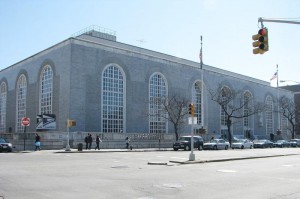
The Bronx General Post Office
Built in 1935, the Bronx post office is the largest of twenty-nine Depression-era post offices in New York City
The four-story Moderne Bronx Post Office was built in 1935 as part of a Treasury Department program to employ out-of-work architects, artisans, and artists. It is one of more than a thousand post offices constructed during FDR’s presidency. At 175,000 square-feet, it is the largest of twenty-nine Depression-era post offices in New York City.
Two sculptures by Charles Rudy and Henry Kreis adorn the outside of the massive building. The lobby contains thirteen murals, entitled “America at Work, painted in 1937 by American artists Ben Shahn and his wife Bernarda Bryson. Shahn (1898-1969), a prolific artist, is known for his works of social realism. His works appear in several government buildings in Washington, D.C. and are in the collections of the Museum of Modern Art, the Whitney Museum, and the Museum of the City of New York.
The Postal Service has faced severe criticism of its disposal of its historic properties, many of which contain artworks intended for the public that paid for them. Last year the New York City Landmarks Preservation Commission designated the lobby of the Bronx Post Office and its murals a historic landmark to give them some protection in the event of a sale.
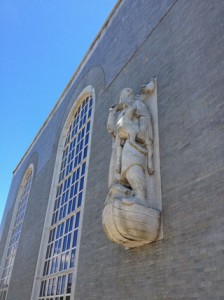
Exterior of the Bronx Post Office
Charles Rudy and Henry Kreis sculptures decorate the landmark building
The U.S. Postal Service receives no public funds, yet in a push to privatize the agency, Republicans in Congress enacted legislation in 2006 requiring the U.S. Postal Service to prepay 75-years of benefits to postal workers within ten years. Without that $5.6 billion prepayment, the USPS would have made a profit of over $600 million last year.
Postal officials have insisted that they must sell thousands of post offices in order to fix the cash-strapped agency. Local opposition to the sale of many post offices led Congress to appoint the Advisory Council on Historic Preservation (ACHP) to look into the matter. In April 2014 the Council recommended that the Postal Service refrains from selling historic post offices until it improves its program and procedures.
The international real estate firm CBRE has the exclusive contract to sell “surplus” post office properties. Until recently, the chairman of the board of CBRE was Richard Blum, the husband of Senator Dianne Feinstein. Blum stepped down as chairman in May, but continues to be a major stockholder. The USPS Inspector General is looking into whether CBRE may be selling postal facilities to its partners at below-market prices at the Postal Service’s expense. Young Woo & Associates, the Korean developer that purchased the Bronx Post Office has done several deals with CBRE. According to Save the Post Office, CBRE CEO Robert Sulentic also serves on the board of directors of Staples, where a pilot program has been underway to see if the Postal Service could cut costs by outsourcing retail services to big box stores.
“It’s not clear why the Postal Service is so reluctant to share information about the sale of the Bronx Post Office, what it sold for, what the plans are, or where the postal retail operation is relocating,” says NYU professor Steve Hutkins, whose Save the Post Office https://www.savethepostoffice.com/search website has been bird-dogging the sell off of the nation’s post offices. Save the Post Office, among the many organizations objecting to the sale. In April, a coalition of elected officials that included New York Mayor Bill De Blasio and Senators Kirsten Gillibrand and Charles Schumer urged that the sale be put on hold. Congressman José Serrano introduced legislation to halt the sales until the Postal Service implements the ACHP recommendations. Hundreds of concerned citizens and postal workers turned out at a public hearing to oppose the sale.
Because the USPS will divulge nothing about the sale of its public property, its fate and that of its great murals remains unclear.
Susan Ives is communications director for the Living New Deal and editor of the Living New Deal newsletter.
